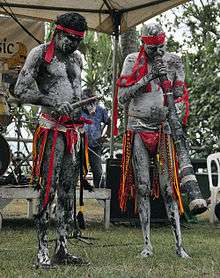Clapstick
Clapsticks, also spelt clap sticks and also known as bilma, bimli, clappers, musicstick or just stick, are a traditional Australian Aboriginal instrument. They serve to maintain rhythm in voice chants, often as part of an Aboriginal ceremony.

They are a type of drumstick, percussion mallet or claves that belongs to the idiophone category. Unlike drumsticks, which are generally used to strike a drum, clapsticks are intended for striking one stick on another.
Origin and nomenclature
In northern Australia, clapsticks would traditionally accompany the didgeridoo, and are called bimli or bilma by the Yolngu people of north-east Arnhem Land in the Northern Territory of Australia.
Boomerang clapsticks
Boomerang clapsticks are similar to regular clapsticks but they can be shaken for a rattling sound or be clapped together.
Technique
The usual technique employed when using clapsticks is to clap the sticks together to create a rhythm that goes along with the song.
Further reading
- A survey of traditional south-eastern Australian Indigenous music by Barry McDonald (book chapter)
- Moyle, Alice M. (1978). Aboriginal Sound Instruments (PDF). Aboriginal SoundInstrumentsAlice M MoyleCompanion Booklet for a CompaCt DisCAustralian Institute of Aboriginal and Torres Strait Islander Studies. ISBN 9781922059468.
- "Clapsticks". University of Melbourne.
- "1788 - Meet Waruwi: Clapping sticks". My Place. Australian Broadcasting Corporation/. 24 December 1999.